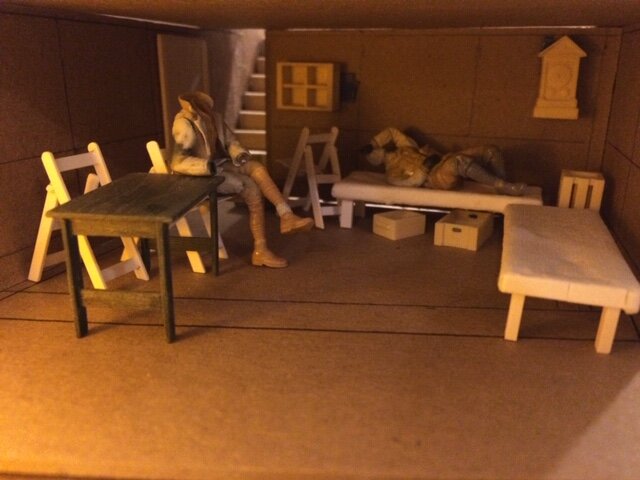THE DUG-OUT
By Jon Harbuck
The Great War inspired great art from some unlikely artists. Among my favorite is Siegfried Sassoon, a decorated infantry officer who lost faith in the war but never broke faith with his soldiers. Sassoon wrote poetry and prose from down in the trenches – the infantryman’s experience of war alien to the official press. His writing is full of stench and venom, and keen affection for the men at the front.
I had wanted to model a British officers’ dugout after seeing a life-sized replica in the Imperial War Museum. Sassoon’s short, ironic poem, The Dug-Out offered inspiration, especially when I found a YouTube recording by “Mad Jack” himself. The poem captures the poet’s thoughts as he studies a young officer sleeping nearby.
Why do you lie with your legs ungainly huddled,
And one arm bent across your sullen, cold,
Exhausted face?
And the poem concludes with a grim observation:
…when you sleep you remind me of the dead.
I had been thinking that the poem’s most vivid image, Deep-shadowed from the candle’s guttering gold, might be captured with flickering light, and I had a preliminary idea how to pull it off: to cannibalize my wife’s battery-powered votive candles (the ones with flickering LED “flames”) to suggest candlelight in the room. Would that work?
A cardboard mock-up convinced me it would work, and Jim DeRogatis’s account of adding sound to his “Pour l’Empereur” box let me hope I could add the poem as a special effect too. In the hospitality suite at the next Chicago Show, I asked Barry Biediger’s opinion of my plan. He gave me a thoughtful look, nodded, and endorsed the idea. But, he asked, “Why not use standard LEDs programmed to flicker, with a micro-LED for a candle flame?” (Fantastic! ... But electronics terrify me; how could I ever manage any of that?) “Don’t worry; I can help.” Sure enough, before I flew home Barry gave me a pocketful of lighting gels; by the holidays he also had shipped me an electronics board with lighting terminals, dimmer pots, and both the flicker and the recording (on a Micro SD card) loaded into the system, with detailed instructions for how to use them.
I let the poem’s basic elements control composition – Mad Jack at a table composing his poem, the sleeping officer sprawled on a cot – and added details from contemporary photos and drawings, the trailer to the film Journey’s End, and the museum piece work of Andy Belsey (who sculpted some of the Tommy’s War trench sections). Even as the elements were coming together I was gifted one more special effects idea: Bill Ottinger suggested adding artillery fire to the sound track. Back to Professor Emeritus Biediger, who mixed various artillery sounds (is there anything you can’t find on YouTube?) which then were added to the SD card. The finished recording – artillery, then the poem, then back to artillery – plays on a 3 ½ minute loop, through a small speaker mounted in the top of the outer box.
The room’s interior is illuminated by three 5mm LEDs. One “cool white” is mounted above the steps, shining cold winter light from the trench above. One “amber” is mounted in the right-hand wall (hidden by a hanging overcoat but suggesting a candle on the shelf) casting fill light to the back wall through an orange gel. The other “amber” is mounted in the ceiling above the table (mostly shielded by an overhead beam) creating a pool of light around the candle; this one projects through a diffuser to soften the edges around the pool of light. I modelled the micro-LED candle and its holder around a soft metal tube; the wire leads to the “flame” running underneath the table and out the side wall (camouflaged by shadow and some hanging straps). Thanks to Barry’s program, each inside LED has a random flicker effect.
The completed scene incorporates all the elements of the poem. And because it depicts Sassoon sitting still and the other officer asleep, the flickering candlelight and artillery rumble give an impression of live action. I don’t claim credit for any of that; Barry provided all the brains and technology, while others provided great ideas. I only hope the finished product lives up to their collective contribution.
Positioning and test-fitting walls and other elements during construction; one of the walls, finished (the design of the bistro sign was adopted from a wine label), and Barry’s electronics card, partially hooked-up.
The original cardboard mock-up; inside the box: speaker up top, lead wires to the interior LEDs visible, and an interior detail shot.






